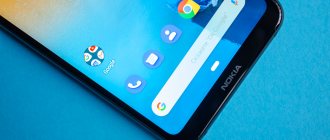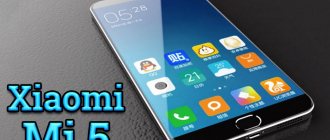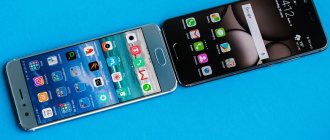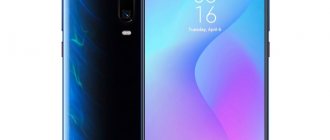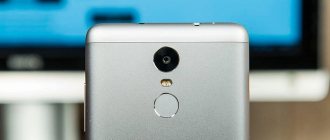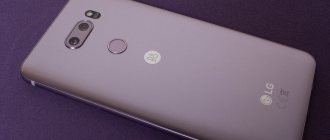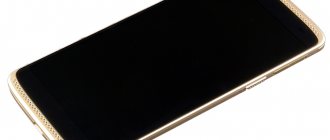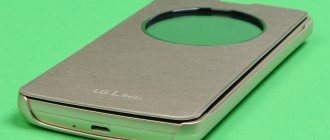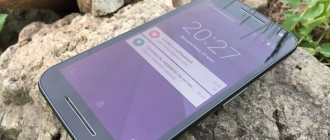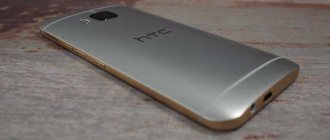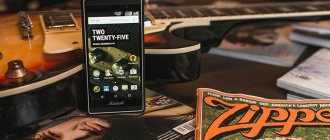When company representatives were asked why they needed their own line of products, they replied that this was how they were preparing for the release of future products that would combine smartphones and popular TP-Link products. We don’t yet know what kind of gadgets these will be, but we can already look at the released smartphones that can be bought in Russia. All TP-Link Neffos models are divided into five lines: N series, X series, C series, Y series and P series. The manufacturer does not yet have expensive flagships. The company believes that great products should not be expensive, so most of the smartphones in these series belong to the mid-range and budget segments. Now let's look at them in detail.
Neffos N1
- Main camera: double, with 12MP+12MP modules
- Front camera: 8MP
- Processor : 8-core Helio P25 processor clocked at 2.5GHz
- Memory: 4 RAM + 64 GB ROM
- Screen: 5.5″ FHD IPS
- Battery: 3260mAh with fast charging
Price: from 15990 rubles
The Neffos N1 smartphone belongs to the middle segment and stands out for its stylish design, decent characteristics and dual camera. The disadvantages include the mediocre battery capacity. With such a screen diagonal and such filling, it is hardly enough for a whole day of active use.
Autonomy TP-Link Neffos C9S
The Neffos C9S has a 3000 mAh battery. This battery is by no means indicative of either the good or the bad side. Despite the lack of resources, we cannot count on particularly long battery life. Standard - one day. If we save energy, we can last up to a day and a half.
As for the battery itself, unfortunately, we do not have access to it. Disadvantages include the lack of support for fast charging and the old Micro-USB connection type. The charger is made of medium quality plastic. The device charges at a power of 5 W (about 1 A and 5 V).
It's a shame that TP-Link didn't include a slightly larger battery and faster charging here, which would have set the device apart from other solutions in this price range. I think many will be tempted by competing phones with better batteries.
Neffos X9
- Main camera: dual, 13MP module
- Screen: 5.99″ HD+ FullView
- Memory: 3 GB RAM + 32 GB ROM
- Processor: 8-core MediaTek MT6750
Price: from 9299 rubles
The Neffos X9 smartphone pleases with a widescreen 6-inch screen, an 8-core chip and a dual-band Wi-Fi module. The disadvantages include the mediocre battery capacity. With such a screen diagonal and such filling, it is hardly enough for a whole day of active use.
Neffos X1 Lite
- Screen: IPS 5.0″ (1280×720 pixels)
- Processor: 8-core MediaTek MT6750
- SIM cards: two, support for microSD cards (up to 128 GB)
- Main camera: double, with 13 MP + 5 MP modules
Price: from 6490 rubles
The advantages of the Neffos X1 Lite model include a compact IPS screen, a modest price, an 8-core chip and a dual camera. The downsides are a weak battery and mediocre display resolution.
Performance and equipment
The smartphone runs on a quad-core MediaTek MT6739WW processor with a maximum clock speed of 1.5 GHz. The Neffos C9A is a low-cost model and we didn't expect great performance from it. However, in the AnTuTu Benchmark tests, the smartphone scored almost 46,000 points, beating the Samsung J2 2020 and the latest Huawei Y5, which received 36,000 points each. Considering the price category of the model, this is a good result.
The gadget is equipped with 2 GB of RAM and 16 GB of internal memory, 11 of which are available to the user. It is possible to install a microSD card up to 128 GB. In general, everything is like most state employees - there is enough RAM to simultaneously run several lightweight applications such as instant messengers, a camera and Google services. You can even install a couple of 3D games, but don’t expect high speed performance in parallel with other applications.
Neffos C9A runs Android 8.1 in the proprietary NFUI 8.0 shell. The OS interface is user-friendly and is almost no different from classic Android. There are practically no pre-installed applications on the smartphone, only standard Google services and programs from TP-Link. Speaking of TP-Link: if you have a router from this manufacturer, you can use your smartphone as a signal booster, access the network using a QR code, and quickly share Wi-Fi access using your smartphone.
You can use two SIM cards on your smartphone and, accordingly, have two phone numbers (Dual SIM Dual Standby). The gadget easily picks up mobile networks of Russian operators and works with 2G/3G/4G.
Wireless interfaces also include Wi-Fi 802.11 (b/g/n), GPS and Bluetooth 4.1. The fingerprint sensor works quickly and flawlessly - just gently touch the sensor to activate the smartphone.
For added security, Neffos supports unlocking using facial recognition. The gadget detects 106 features of your face and remembers them. This method does not work as quickly as the sensor - it takes about one and a half seconds to analyze and unlock. In the dark, recognition is unstable, so you are unlikely to use this function all the time.
Neffos X1 Max
- Screen: IPS 5.5″ (1920×1080 pixels)
- Processor: 8-core Helio P10
- SIM cards: two, support for microSD cards (up to 128 GB)
- Main camera: double, with 13 MP + 5 MP modules
Price: from 8890 rubles
Neffos X1 Max stands out for its high-quality display resolution, dual camera and large amount of built-in flash memory. Once again, the manufacturer’s model is let down by a mediocre battery, which is hardly enough for a whole day of full-fledged use of the smartphone.
Review of the balanced TP-Link Neffos N1 smartphone with a decent camera
TP-Link demonstrated its flagship smartphone to the world in early spring during the MWC world exhibition in Barcelona. It was a stylish device in a metal case with a 5.5-inch screen, called Neffos N1. And only at the very end of spring the Russian market waited for the official release of the new product on the shelves. The smartphone turned out to be very interesting in some ways for its price level; you will learn all the details in our Neffos N1 review.
Main characteristics of Neffos N1 (TP908A)
- SoC MediaTek MT6757CD, 8 cores ARM Cortex-A53 @1.7/2.4 GHz
- GPU Mali-T880 MP2 @900 MHz
- Operating system Android 7.1
- Touch display IPS 5.5″, 1920×1080 (16:9), 403 ppi
- Random access memory (RAM) 4 GB, internal memory 64 GB
- Nano-SIM support (2 pcs.)
- MicroSD support up to 128 GB
- GSM/WCDMA/HSPA+ networks
- LTE FDD Cat.4 networks (1/3/5/7/8/20)
- Wi-Fi 802.11ab/g/n/ac (2.4 and 5 GHz)
- Bluetooth 4.2
- USB Type-C, USB OTG
- GPS, A-GPS, Glonass
- Main camera 12 MP f/2.0 + 12 MP f/2.0, autofocus, 1080p
- Front camera 8 MP, f/2.2, fixed focus
- Proximity and light sensors, magnetometer, accelerometer, gyroscope
- Fingerprint's scanner
- Battery 3260 mAh
- Dimensions 154×76×7.5 mm
- Weight 165 g
| average price | find out prices |
| Retail offers | find out the price |
Contents of delivery
The smartphone comes complete with a USB cable, a network adapter with variable output current and voltage, a wired stereo headset and a card eject key. Also included in the kit you can find paper documentation in Russian and a protective glass for the screen.
Appearance and ease of use
Neffos N1 has a nice and practical all-metal body with an unoriginal, but quite pleasant-looking design, copying both the iPhone and Huawei smartphones.
The corners of the thin body are strongly rounded, and a transparent insert in the upper part of the back wall, behind which the camera eyes and flashes are hidden, reminds us of Huawei devices.
There are no complaints about the quality of materials or assembly - everything fits neatly, the case does not creak when compressed, it feels solid. The matte surface of the case is very slippery, so a case will come in handy.
The cameras on the back do not protrude beyond the body, so the smartphone lies stable on the table and does not wobble when you touch the screen. Two separate camera eyes are adjacent to two bright two-color flash LEDs located behind one window.
The fingerprint scanner area is slightly recessed, it is easy to find by touch, and it stands out well tactilely. There are no complaints about the work of the scanner; it works clearly, without errors in recognition. A bonus is that the scanner is protected from moisture.
An LED event indicator was placed on the front panel, which is commendable. But there is no flash for the front camera.
Below the screen there are three touch-sensitive hardware buttons that have their own soft, but quite noticeable backlight, which is nice.
The side keys are spaced on both sides, and this is bad because when you press one of them, the other finger automatically rests on the opposite button. Considering that the key travel is flexible, erroneous presses are common. Buttons have been installed on one side for a long time, all manufacturers have come to this, there is no need to break established rules.
You can note the presence of a separate button to turn off the sound - a two-position slider, like on the iPhone. This is an endlessly convenient functionality that for some reason most manufacturers ignore. For this, you can forgive the remaining buttons being spaced on two sides.
The card slot is hybrid: it can accommodate two Nano-SIM cards or a memory card with one SIM card. Hot swap supported.
There is nothing on the top end except the auxiliary microphone hole.
At the bottom end, the USB port is represented by a modern and up-to-date Type-C connector. At the same time, there is also a 3.5 mm headphone output; this combination is optimal, but, unfortunately, it is very rare today. The main speaker, as well as the conversational microphone, are also located here, at the bottom end.
Neffos N1 goes on sale in only one body color option - black. The smartphone did not receive protection from water and dust.
Screen
Neffos N1 is equipped with an IPS display covered with protective 2.5D Gorilla Glass 3. The 5.5” screen has a resolution of 1920×1080, its physical dimensions are 68×121 mm. The frame around the display is wide: 4 mm on the sides, 16 mm on the top and 18 mm on the bottom.
It is possible to use automatic brightness adjustment based on the operation of the ambient light sensor. Multi-touch tests diagnose support for 10 simultaneous touches. It even supports gloved operation mode, which is commendable.
A detailed examination using measuring instruments was carried out by the editor of the “Monitors” and “Projectors and TV” sections Alexey Kudryavtsev
. Here is his expert opinion on the screen of the sample under study.
The front surface of the screen is made in the form of a glass plate with a mirror-smooth surface that is scratch-resistant. Judging by the reflection of objects, the anti-glare properties of the screen are approximately the same as those of the Google Nexus 7 (2013) screen (hereinafter simply Nexus 7). For clarity, here is a photo in which a white surface is reflected in the switched off screens (on the left - Nexus 7, on the right - Neffos N1, then they can be distinguished by size):
The screen of the Neffos N1 is slightly darker (brightness according to photographs is 119 versus 121 for the Nexus 7). The ghosting of reflected objects in the Neffos N1 screen is very weak, this indicates that there is no air gap between the layers of the screen (more specifically, between the outer glass and the surface of the LCD matrix) (OGS - One Glass Solution type screen). Due to the smaller number of boundaries (glass/air type) with very different refractive indices, such screens look better in conditions of intense external illumination, but their repair in the case of cracked external glass is much more expensive, since the entire screen has to be replaced. On the outer surface of the screen there is a special oleophobic (grease-repellent) coating, which is noticeably better in efficiency than that of the Nexus 7, so fingerprints are removed much more easily and appear at a lower speed than in the case of regular glass.
When manually controlling the brightness and displaying the white field in full screen, the maximum brightness value was about 550 cd/m², the minimum was 1.7 cd/m². The maximum brightness is very high, therefore, given the excellent anti-glare properties, screen readability even on a sunny day outdoors should be at a good level. In complete darkness, the brightness can be reduced to a comfortable value. There is automatic brightness adjustment based on the light sensor (it is located to the left of the front speaker slot). In automatic mode, as external lighting conditions change, the screen brightness both increases and decreases. The operation of this function depends on the position of the brightness adjustment, with which the user can try to set the desired brightness level in the current conditions. If you do not interfere, in complete darkness the auto-brightness function reduces the brightness to 3.4 cd/m² (very low), in an artificially lit office (approximately 550 lux) it sets it to 310 cd/m² (normal), in a very bright environment ( corresponds to lighting on a clear day outdoors, but without direct sunlight - 20,000 lux or a little more) increases to 550 cd/m² (to the maximum, as needed). The backlight brightness level depends on the position of the slider in dark and average conditions, but in very bright environments it is always set to maximum. We were not satisfied with the default result, so we moved the slider a little to the right in complete darkness and for the three conditions indicated above, we got 30, 155-335 and 550 cd/m² (the ideal combination). Note that in an office environment, the steady-state brightness value depends on whether the transition occurs from conditions of complete darkness or from bright light. It turns out that the auto-brightness function works adequately and allows the user to customize their work to individual requirements. At any brightness level, there is no significant backlight modulation, so there is no screen flicker.
This smartphone uses an IPS matrix. The microphotographs show a typical IPS subpixel structure:
For comparison, you can see the gallery of microphotographs of screens used in mobile technology.
The screen has good viewing angles without significant color shift even with large viewing deviations from perpendicular to the screen and without inverting shades. For comparison, here are photographs in which identical images are displayed on the screens of Neffos N1 and Nexus 7, while the screen brightness is initially set to approximately 200 cd/m², and the color balance on the camera is forcibly switched to 6500 K.
There is a white field perpendicular to the screens:
Note the good uniformity of brightness and color tone of the white field.
And a test picture:
The colors on the Neffos N1's screen are slightly oversaturated and the color balance varies between screens.
Now at an angle of approximately 45 degrees to the plane and to the side of the screen:
It can be seen that the colors did not change much on both screens, but on the Neffos N1 the contrast decreased to a greater extent due to the greater brightening of blacks.
And a white field:
The brightness of the screens at an angle has decreased (by at least 4 times, based on the difference in shutter speed), but the Neffos N1 screen is still a little brighter. When deviated diagonally, the black field brightens greatly and acquires a red-violet hue. The photographs below demonstrate this (the brightness of the white areas in the direction perpendicular to the plane of the screens is the same!):
And from another angle:
When viewed perpendicularly, the uniformity of the black field is good:
The contrast (approximately in the center of the screen) is high - about 1400:1. The response time for the black-white-black transition is 29 ms (14 ms on + 15 ms off). The transition between halftones of gray 25% and 75% (based on the numerical value of the color) and back takes a total of 47 ms. The gamma curve, constructed using 32 points with equal intervals based on the numerical value of the shade of gray, did not reveal any blockage in either the highlights or the shadows. The exponent of the approximating power function is 2.17, which is slightly lower than the standard value of 2.2. In this case, the real gamma curve noticeably deviates from the power-law dependence:
This device has an aggressive dynamic adjustment of the backlight brightness in accordance with the nature of the displayed image - on dark images, the backlight brightness decreases. As a result, the resulting dependence of brightness on hue (gamma curve) does not correspond to the gamma curve of a static image, since the measurements were carried out with sequential display of shades of gray on almost the entire screen. For this reason, we carried out a number of tests - determining contrast and response time, comparing black illumination at angles - (however, as always) when displaying special templates with a constant average brightness, and not monochromatic fields in the entire screen. In general, such a non-switchable brightness correction does nothing but harm, since constantly changing the screen brightness can at least cause some discomfort, reduce the visibility of gradations in shadows in the case of dark images and the readability of the screen in bright light, since in average images the brightness is not the lightest backlight is reduced.
Color gamut is slightly wider than sRGB:
Let's look at the spectra:
The spectra of the components are well separated, which results in a wide color gamut. We have already seen this in the case, for example, of the Sony Xperia Z2 and other mobile devices. Sony indicates that these screens use LEDs with a blue emitter and green and red phosphors (usually a blue emitter and a yellow phosphor), which, in combination with special matrix filters, allows for a wide color gamut. Yes, and the red phosphor apparently uses so-called quantum dots. For a consumer device, a wide color gamut is not an advantage, but a significant disadvantage, since as a result, the colors of images - drawings, photographs and films - oriented to the sRGB space (and the vast majority of them) have an unnatural saturation. This is especially noticeable on recognizable shades, such as skin tones. The result is shown in the photographs above.
The balance of shades on the scale is a compromise, since the color temperature is significantly higher than the standard 6500 K, but the deviation from the blackbody spectrum (ΔE) is below 10, which is considered an acceptable indicator for a consumer device. At the same time, color temperature and ΔE change little from hue to hue - this has a positive effect on the visual assessment of color balance. (The darkest areas of the gray scale can be ignored, since color balance there is not very important, and the error in measuring color characteristics at low brightness is large.)
There is a fancy setting that allows you to reduce the intensity of the blue component.
Marketers tried to intimidate the user in order to show the level of care of the manufacturer. Of course, there is no risk to your eyesight. In principle, bright light can lead to disruption of the circadian rhythm (see the article about the iPad Pro with a 9.7-inch display), but everything can be solved by adjusting the brightness to a comfortable level, and there is absolutely no way to distort the color balance, reducing the contribution of blue sense.
However, this setting can be used to correct the color balance. In the graphs above, the curves are Without corr.
correspond to the results without any color balance correction, and the curves
Corr.
— data obtained after moving the slider to the position indicated in the picture above. It can be seen that the change in balance corresponds to the expected result, since the color temperature approached the standard value, and ΔE remained almost unchanged. There is some benefit from this correction - however, the maximum brightness has decreased to 470 cd/m².
To summarize: the screen has a very high maximum brightness and has excellent anti-glare properties, so the device can be used outdoors even on a sunny summer day without any problems. In complete darkness, the brightness can be reduced to a comfortable level. It is also possible to use a mode with automatic brightness adjustment, which works adequately. Also, the advantages of the screen include an effective oleophobic coating, the absence of air gaps in the layers of the screen and flickering, high contrast, good uniformity of the black field and good (after correction) color balance. The disadvantages are the low stability of black to the deviation of the gaze from perpendicular to the screen plane, an excessively wide color gamut and non-switchable brightness correction depending on the displayed image. Nevertheless, taking into account the importance of characteristics for this particular class of devices, the quality of the screen can be considered high.
Cameras
The front camera in Neffos N1 has an 8 MP sensor and an f/2.2 aperture lens. The quality of shooting in normal lighting is very good, although the white balance is not always perfect, and in the case of selfie shots this is important (the color of cars and houses in the photos can be anything within reasonable limits, but a jaundiced or bluish tint to the face is a defect) . There is a Beautify mode, which at the maximum level completely removes all skin textures, making the face “porcelain.”
The main camera is dual: both modules use a 12 MP sensor and an f/2.0 aperture lens. In this case, the Sony IMX386 RGB sensor captures the color spectrum of the image, and the monochrome sensor is responsible for detail. There is also a fashionable function for blurring the background in portrait mode, but this effect is achieved purely in software, and the camera is not always able to clearly identify the subject - along with the background, sometimes the textures of the subject itself suffer. Yes, and the auto-adjustment of white balance leaves much to be desired.
If you leave the notorious background blur effect alone, the camera produces good portraits with decent detail detail both during the day outdoors and indoors.
There are no problems with macro photography; the camera successfully recognizes the front object and focuses on it, blurring the rear ones. When shooting text, you can sometimes notice less sharp areas at the edges of the frame, but overall the camera copes well with this task.
Pro mode allows you to manually adjust white balance, focus method, light sensitivity (up to ISO 1600), shutter speed and exposure compensation. There are also sliders for manually adjusting saturation, brightness and contrast. There is no standard option to save pictures in RAW.
Examples of photos taken with the main camera:
Overall the camera is very good. Sharpness is high across the entire field of the frame, noise reduction works quite accurately. In the dark, when it is no longer possible to cope with the noise, the noise reduction switches to a kind of delicate mode, removing only color artifacts and leaving the grain untouched, which is perceived by the eye adequately and without disgust, and when reduced, such pictures generally look great. In short, in terms of cameras, the Neffos N1 was able to surprise us; we never expected such high quality from a smartphone priced less than 20 thousand rubles.
The camera can shoot video in a maximum resolution of 4K at 30 fps. There is no optical stabilization. In general, the camera copes with video shooting averagely. The sharpness is normal, and even the detail is high, but the color rendition is unnatural; the program paints everything in caustic, unnatural colors. There are no special complaints about the sound recording; the sound is clear, without noticeable distortion.
Video examples:
- Video No. 1 (31 MB, 3840× [email protected] fps, H.264, AAC)
- Video No. 2 (47 MB, 3840× [email protected] fps, H.264, AAC)
- Video No. 3 (37 MB, 3840× [email protected] fps, H.264, AAC)
- Video No. 4 (40 MB, 3840× [email protected] fps, H.264, AAC)
Telephone and communications
Neffos N1 has support for LTE Cat.4 networks (data exchange speed 150/50 Mbit/s). Depending on the region, a smartphone can support a number of LTE FDD frequency bands, including all three used in Russia (Band 3, 7, 20). In the networks of Moscow operators within the city limits, the device registers quickly and works reliably.
It also supports two Wi-Fi bands (2.4 and 5 GHz), there is Bluetooth 4.2, but there is no NFC module.
The navigation module works with GPS (with A-GPS) and with the domestic Glonass, but without the Chinese Beidou. The first satellites during a cold start are detected within the first minute. The smartphone has a magnetic compass, necessary for navigation programs.
The phone application supports Smart Dial, that is, while dialing a phone number, a search is immediately carried out by the first letters in contacts. Methods for sorting and displaying contacts are standard for the Android interface.
In conversational dynamics, the voice of a familiar interlocutor is recognizable, the sound is clear, and the volume margin is sufficient. The vibration alert is noticeable. There is a standard ability to record telephone conversations from the line.
The platform supports active standby of both SIM cards in 3G/4G simultaneously. That is, the SIM card can be in active standby on a 3G/4G network, and not just on 2G, even if another card is assigned to transmit data on 4G. The cards operate in Dual SIM Dual Standby mode, there is only one radio modem.
Software and multimedia
As a software platform, Neffos N1 uses Android OS, a slightly outdated version 7.1 with its own shell and the ability to update over the air (OTA). The official website promises an update to version 8.0, but it has not arrived yet. Soon the eighth version will be outdated, but it still hasn’t arrived...
NFUI (Neffos User Interface, the user interface of Neffos smartphones) in general does not greatly modify the proprietary Android interface. Added support for gestures and a virtual on-screen multifunction button. There is an application cloning mode for working with different accounts on social networks, and you can customize the navigation button bar to your taste. A set of useful utilities includes a voice recorder, a compass, and a file manager, but there was neither an FM radio nor a phone manager that is familiar to Chinese devices and performs comprehensive system monitoring.
In terms of sound, the Neffos N1 does not demonstrate anything special; the sound through the loudspeaker is simple, but the maximum volume level is acceptable. The sound is clearly better with headphones, but this is still not a solution for music lovers. The sound is generally pleasant to the ear, but the breadth of the frequency range is not pleasing. The recorder demonstrates good sensitivity and recording quality.
Performance
Neffos N1 uses the MediaTek MT6757CD single-chip system as its hardware platform, also called Helio P25. This 16nm SoC is configured with an octa-core processor, with 4 ARM Cortex-A53 cores clocked at 1.7 GHz and another 4 at 2.4 GHz. A dual-core Mali-T880 (MP2) video accelerator with a maximum frequency of 900 MHz is responsible for graphics processing. The amount of RAM is 4 GB, and the built-in flash memory is 64 GB. Of these, about 54 GB are free.
It is possible to expand the memory by installing microSD cards, but the system does not offer installation of applications on the memory card. You can connect external flash drives in USB OTG mode.
MediaTek Helio P25 is a weak platform at the moment, it is approximately at the level of Qualcomm Snapdragon 626 in terms of processor computing, but its graphics accelerator does not support the Vulkan API.
The platform's capabilities are still sufficient for basic needs and tasks, but such a smartphone does not have a performance reserve for the future. As for games, most of them do not experience problems, although the most demanding ones, like Injustice 2, slow down.
Testing in comprehensive tests AnTuTu and GeekBench:
For convenience, we have compiled all the results we obtained when testing the smartphone in the latest versions of popular benchmarks into tables. The table usually adds several other devices from different segments, also tested on similar latest versions of benchmarks (this is done only for a visual assessment of the obtained dry figures). Unfortunately, within the framework of one comparison it is impossible to present the results from different versions of benchmarks, so many worthy and relevant models remain “behind the scenes” - due to the fact that they once passed the “obstacle course” on previous versions of test programs.
| Neffos N1 (MediaTek MT6757CD) | Alcatel 5 (MediaTek MT6750) | Vivo V9 (Qualcomm Snapdragon 626) | Meizu m6s (Samsung Exynos 7872) | Honor 9 lite (HiSilicon Kirin 659) | |
| AnTuTu (v7.x) (bigger is better) | 81947 | 52404 | 90155 | 92315 | 87589 |
| GeekBench (v4.x) (bigger is better) | 945/4045 | 608/2518 | 942/4650 | 1321/3190 | 930/3625 |
Testing the graphics subsystem in gaming tests 3DMark, GFXBenchmark and Bonsai Benchmark:
When testing in 3DMark, the most powerful smartphones now have the ability to run the application in Unlimited mode, where the rendering resolution is fixed at 720p and VSync is disabled (which can cause the speed to rise above 60 fps).
| Neffos N1 (MediaTek MT6757CD) | Alcatel 5 (MediaTek MT6750) | Vivo V9 (Qualcomm Snapdragon 626) | Meizu m6s (Samsung Exynos 7872) | Honor 9 lite (HiSilicon Kirin 659) | |
| 3DMark Ice Storm Sling Shot ES 3.1 (bigger is better) | 703 | 301 | 474 | 420 | 311 |
| 3DMark Ice Storm Sling Shot Ex Vulkan (bigger is better) | — | — | 424 | 341 | 362 |
Browser cross-platform tests:
As for benchmarks for assessing the speed of the javascript engine, you should always make allowance for the fact that their results significantly depend on the browser in which they are launched, so the comparison can only be truly correct on the same OS and browsers, and this is possible during testing not always. For Android OS, we always try to use Google Chrome.
| Neffos N1 (MediaTek MT6757CD) | Alcatel 5 (MediaTek MT6750) | Vivo V9 (Qualcomm Snapdragon 626) | Meizu m6s (Samsung Exynos 7872) | Honor 9 lite (HiSilicon Kirin 659) | |
| Mozilla Kraken (ms, less is better) | 10250 | 14182 | 17080 | 4463 | 9666 |
| Google Octane 2 (bigger is better) | 4973 | 3198 | 2459 | 8450 | 4696 |
| SunSpider (ms, less is better) | 1312 | 1812 | 2146 | 859 | 1320 |
AndroBench memory speed test results:
Thermal photographs
Below is a thermal image of the rear
surface obtained after 10 minutes of battery testing in the GFXBenchmark program:
Heating is more localized in the upper part of the device, which apparently corresponds to the location of the SoC chip. According to the heat camera, the maximum heating was only 35 degrees (at an ambient temperature of 24 degrees), which is relatively little.
Playing video
To test the omnivorous nature of video playback (including support for various codecs, containers and special features, such as subtitles), we used the most common formats, which make up the bulk of the content available on the Internet. Note that for mobile devices it is important to have support for hardware video decoding at the chip level, since it is most often impossible to process modern options using processor cores alone. Also, you shouldn’t expect a mobile device to decode everything, since the leadership in flexibility belongs to the PC, and no one is going to challenge it. All results are summarized in a table.
| Format | Container, video, sound | MX Video Player | Standard video player |
| 1080p H.264 | MKV, H.264 1920×1080, 24 fps, AAC | plays normally | plays normally |
| 1080p H.264 | MKV, H.264 1920×1080, 24 fps, AC3 | plays normally | no sound |
| 1080p H.265 | MKV, H.265 1920×1080, 24 fps, AAC | plays normally | plays normally |
| 1080p H.265 | MKV, H.265 1920×1080, 24 fps, AC3 | plays normally | no sound |
Further testing of video playback was performed by Alexey Kudryavtsev
.
This device apparently does not support DisplayPort Alt Mode for USB Type-C - outputting image and sound to an external device when connected to a USB port - which was discovered using the Tronsmart CTHA1 adapter. Therefore, we had to limit ourselves to testing the output of video files on the screen of the device itself.
To test the output of video files on the screen of the device itself, we used a set of test files with an arrow and a rectangle moving one division per frame (see “Method for testing video playback and display devices. Version 1 (for mobile devices)”). Screenshots with a shutter speed of 1 s helped determine the nature of the output of frames of video files with various parameters: the resolution varied (1280 by 720 (720p), 1920 by 1080 (1080p) and 3840 by 2160 (4K) pixels) and frame rate (24, 25, 30, 50 and 60 fps). In the tests we used the MX Player video player in the “Hardware” mode. The test results are summarized in the table:
| File | Uniformity | Passes |
| 4K/60p (H.265) | Badly | a lot of |
| 4K/50p (H.265) | Badly | a lot of |
| 4K/30p (H.265) | Fine | No |
| 4K/25p (H.265) | Fine | No |
| 4K/24p (H.265) | Fine | No |
| 4K/30p | Fine | No |
| 4K/25p | Fine | No |
| 4K/24p | Fine | No |
| 1080/60p | Fine | No |
| 1080/50p | Fine | No |
| 1080/30p | Fine | No |
| 1080/25p | Fine | No |
| 1080/24p | Fine | No |
| 720/60p | Fine | No |
| 720/50p | Fine | No |
| 720/30p | Fine | No |
| 720/25p | Fine | No |
| 720/24p | Fine | No |
Note: If both columns have Uniformity
and
Skips
are given
green
ratings, this means that, most likely, when watching films, artifacts caused by uneven alternation and skipping of frames will either not be visible at all, or their number and visibility will not affect the viewing comfort. Red marks indicate possible problems with playback of the corresponding files. According to the frame output criterion, the quality of playback of video files on the screen of the smartphone itself is good, since in most cases frames (or groups of frames) can (but are not required) be output with more or less uniform alternation of intervals and without skipping frames. However, there is no ideal smoothness in the case of 60 fps files, since the screen refresh rate is 63 Hz, so at least three frames per second are output with an increased duration. When playing video files with a resolution of 1920 by 1080 pixels (1080p), the image of the video file itself is displayed one to one pixel by pixel, exactly at the height of the screen (in landscape orientation) and in true Full HD resolution. The brightness range displayed on the screen corresponds to the actual range in the video file, so all gradations of shades are displayed in the shadows and highlights, which is required for correct playback of video files. Note that this smartphone does not support hardware decoding of H.265 files with a color depth of 10 bits per color.
Battery life
The non-removable battery installed in Neffos N1 has a capacity of 3260 mAh. This is a completely adequate battery capacity for a modern smartphone, and the hero of the review demonstrates with it quite typical average battery life results, not record-breaking, and not even above average. In real life, the device, depending on the usage scenario, will last a day until evening charging, a maximum of a day.
Testing has traditionally been done at normal power consumption levels without using power-saving features.
| Battery capacity | Reading mode | Video mode | 3D Game Mode | |
| Neffos N1 | 3260 mAh | 16:20 | 8:15 a.m. | 4:00 am |
| Alcatel 5 | 3000 mAh | 15:15 | 7:00 am | 3 hours 50 minutes |
| Vivo V9 | 3260 mAh | 20:00 | 10:00 am | 6:00 am |
| Meizu M6s | 3000 mAh | 13:00 | 10:00 am | 4 hours 20 minutes |
| Honor 9 lite | 3000 mAh | 21:20 | 11:10 am | 4 hours 40 minutes |
Continuous reading in the Moon+ Reader program (with a standard, light theme) at a minimum comfortable brightness level (brightness was set to 100 cd/m²) with auto-scrolling lasted about 16.5 hours until the battery was completely discharged, and with continuous viewing of high-quality videos ( 1080p) with the same brightness level via a home Wi-Fi network, the device operates for more than 8 hours. In 3D gaming mode, the smartphone can work for up to 4 hours, depending on the specific game.
The smartphone supports fast charging, so it charges from its own AC adapter within 2 hours, the initial current and voltage values are 2.1 A 7.2 V. The smartphone does not support wireless charging.
Bottom line
The new model from TP-Link does not compete with flagship solutions from other manufacturers; it does not have a Full View screen, a top-end processor or NFC, but at the same time, the N1 may well become an interesting alternative among devices with similar technical characteristics in the mid-price segment.
But on the other hand, such important components of any mobile device as the screen and camera are very good here, especially considering the level of positioning of the smartphone: now in Russian retail a device with an official two-year warranty can be purchased for only 16 thousand rubles, and this allows you to close your eyes for many shortcomings. However, the smartphone has no real shortcomings as such: no outright defects or defects were identified, the manufacturer TP-Link is responsible for the quality of its products in this regard. So, for such little money, a device with a good large screen and a very good camera, and even in a solid metal case, is quite worthy of the closest attention of lovers of inexpensive, balanced purchases.
In conclusion, we suggest watching our video review of the Neffos N1 smartphone:
You can also watch our video review of the Neffos N1 smartphone on iXBT.Video
Neffos X1
- Screen: IPS 5.0″ (1280×720 pixels)
- Processor: 8-core MediaTek MT6750
- SIM cards: two, support for microSD cards (up to 128 GB)
- Main camera: double, with 13 MP + 5 MP modules
Price: from 7990 rubles
Pros of Neffos X1: 8-core processor, compact screen, dual main camera with autofocus. The disadvantages include low screen resolution, small amount of RAM and ROM.
Neffos C9
- Main camera: 13 MP
- Front camera: 8 MP Softlight camera
- Screen: 5.99″ HD+ IPS FullView
- Battery: 3840 mAh
Price: from 7699 rubles
The Neffos C9 smartphone stands out with its large widescreen display, powerful battery and high-quality selfie camera. Its weaknesses include a single main camera and a small amount of RAM and ROM.
Cameras
The main camera has 5 megapixels. This means that it is not suitable for normal photographs. It takes pictures normally only in excellent lighting conditions. In low or even medium lighting, pictures come out blurry. But there is a camera release and image autofocus. You don't often see this in public sector companies. The image detail is at a very low level, but if you take competitors’ phones for this price, the main camera of the TP-Link Neffos C5A looks pretty decent.
The smartphone is capable of recording video in a resolution of 1920x1020. However, given the weak camera module, this advantage will not allow you to record good video. Electronic stabilization slightly smooths out these disadvantages.
The quality of the front camera is only suitable for video calls on Skype. Resolution is only 2 megapixels. Only programs such as Skype can more or less work with this camera. If you try to make a call in Viber, the maximum that will be on the screen is the pixels that cover your face. Of course, you can see the face, but this will be a big problem.
The camera menu has face enhancement and panorama modes, but they also work poorly.
Neffos C9A
- Main camera: 13 MP
- Front camera: 5 MP Softlight camera
- Screen: 5.45″ HD+ IPS FullView
- Battery: 3020 mAh
Price: from 6799 rubles
The advantages of the Neffos C9A include a modern FullView screen, a compact body with a large diagonal and a reasonable price. The disadvantages include a single main camera and mediocre battery capacity.
Neffos C7
- Main camera: 13 MP
- Front camera: 8 MP
- Screen: 5.5″ HD (1280×720 pixels) IPS
- Battery: 3060 mAh
Price: from 7190 rubles
The Neffos C7 model will please the user with its price, compact size and IPS matrix. The only disadvantages here are the small amount of RAM and ROM, as well as a single main camera.
Neffos C5A
- Main camera : 5 MP
- Front camera: 2 MP
- Screen: TN-matrix, 5 inches (854×480 pixels)
- Processor: MediaTek MT6580M
- Battery: 2300 mAh
Price: from 3990 rubles
Neffos C5A stands out for its compact size, powerful battery for its display size and resolution, and a very reasonable price. Among the shortcomings, the low screen resolution and small amount of RAM and ROM are striking.
Performance
It also doesn't stand out much in terms of performance. A typical budget phone with a MediaTek processor is the MT6580. The processor is equipped with 4 cores with a clock frequency of 1.3 GHz. Mali-400 MP2 serves as the video core. The developers allocated little memory: 8 gigabytes of built-in and 1 gigabyte of RAM. Such a RAM will handle the weakest games, but will start to slow down on medium ones.
The phone itself works quite quickly and without sagging. Perfect for the average user who is interested in listening to music, chatting in instant messengers, surfing the Internet and just making calls. It will be difficult for the phone to handle other functions.
Neffos Y5s
- Main camera: 8 MP
- Front camera: 2 MP
- Screen: IPS, 5 inches (1280 by 720 pixels)
- Processor: Snapdragon 212
- Battery: 2450 mAh
Price: from 5499 rubles
The Neffos Y5s model will appeal to users with its IPS screen, Qualcomm processor, compact size and adequate battery capacity. And you may not like single cameras with low-resolution modules.
Setting up Wi-Fi on the router
Works in two frequency ranges simultaneously, maximum data transfer speeds up to 1300 Mbit/s at 5 GHz and 450 Mbit/s at 2.4 GHz. Total throughput up to 1.75 Gbps.
First, turn on both networks (or you can turn on only one). Go to Dual Band Selection and check the box Concurrently with 2.4GHz and 5GHz.
There are two tabs in the side menu - Wireless 2.4GHz and Wireless 5GHz . We configure both networks. The names of the set should be different.
Wireless 2.4GHz
- Wireless Network Name - the name of your wireless network
- Region : You can choose Russia, or you can choose nothing. It's not critical.
- Mode (Standard): 11bgn mixed
- Next, click Save
Wireless 5GHz
- Wireless Network Name - the name of your wireless network
- Region : You can choose Russia, or you can choose nothing. It's not critical.
- Mode (Standard): 11bgn mixed
- Next, click Save
We configure Wi-Fi encryption for each network. The passwords may be the same. In the side menu go to Wireless Security :
- Select the encryption type WPA-PSK/WPA2-PSK
- PSK Password : enter the password for the Wi-Fi network. The password must not be less than 8 characters
- Click the Save . After saving the settings, you will be prompted to reboot the router, ignore this requirement (red text below)
